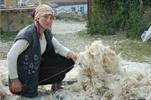Most of Azerbaijan's scenic highlights lie in the spectacular, snow-capped Caucasus mountains or their luxuriantly forested foothills. Some of these zones are accessible from the delightful Baku-Balakan road, others from the Quba-Qusar region, where Laza and Xynalyq are Azerbaijan's most magnificently set mountain villages. Both northern and northwestern Azerbaijan offer truly extraordinary contrasts with the semi-desert landscapes around Baku. However, unless you're prepared to walk for a couple of days across high passes, there's no way to cross between the two.
North of Baku, the scrubby desert gradually transforms via orchard lands (around Quba) into oak forests nuzzling at Nabran's grey sand beaches. Short, easy diversions en route take you to the dramatically-coloured 'Candy Cane' mountains, the castle ruin at Chirax, and the mysterious shamenesque pinnacle of Besh Barmaq.
With more time and a 4WD vehicle, tough summer adventures are possible to timeless villages such as Laza, Cek and Xinaliq. These are blended into some of Azerbaijan's loveliest scenery - breathtaking chasms, canyons and bald-peaked mountains with excellent hiking, climbing and camping opportunities.
Driving from Baku takes about 1.5 hours to Besh Barmaq, 3 hrs to Quba, 4.5 (by 4WD) to Laza.
Baku to Quba
The region's real highlights start beyond Quba. Nonetheless there are some interesting diversions en route, best suited for those with a vehicle. At Gilazi, a newly asphalted side lane runs west towards the gently attractive woodland of the Alty Agach National Park. It passes an eye-catching area nicknamed the Candycane Mountains, where vivid pink-and-white striped hills are full of little conical fossils. North of Gilazi the coastal plain narrows. In past times a series of walls and fortresses would have controlled travel along the ancient trade route between Derbent (Dagestan, Russia) and Baku. Today sparse fortress remnants remain on dramatic, spiritually fascinating Beshbarmaq Dag with a more sizeable castle ruin at Chirax Qala.
REGIONAL HISTORY
During the Albanian period the coastal plain represented a profitable trade route or a devastating invitation to invaders according to the era. Thus the main architectural efforts were put into a massive series of fortification projects. More extensive than Hadrian's Wall, the defences were on a scale bettered only by the Great Wall of China.
The three main walls aimed at funnelling any movement of trade (or possible invaders) through controllable gateways. Most impressive was the 120km long, 10m-thick earthen ramparts whose famous Great Iron Gate was at Derbend. 42km of this was later reinforced by the 16th-century Azeri-Persian emperor Shah Ismail I (Xatai) but now lies within Russian Dagestan.
The two more southerly wall routes were (a) from Chirax Castle to Gilgilcahi (near Davachi), spanning the shorter plain between Besh Barmaq and the coast. There would have been further defences along the Samur river which forms today's Russo-Azen border. As in China, these walls were never demolished as such, just left to decay. The stretches which were built of stone have since been cannibalized for house building, so today it takes a lot of imagination to make out where they once stood.
Power over the area was wielded alternately from Derbend, Shamakha or Baku until the late 17th century with the rise of a minor local khanate based at Xudat.
In the 18th century the Xudat khan transferred his power base to Quba which rose rapidly to regional prominence. Quba briefly became one of the strongest power centres in Azerbaijan under Fatali Khan who tried, semi-successfully, to unite the squabbling Azeri potentates as a counterbalance to the growing threat from Persia. However, his 1784 defence treaty with Russia paved the way for eventual annexation and, in 1806, Russia abolished the khanate altogether.
If you're planning a trip to Azerbaijan you may be interested ▶ Azerbaijan highlights - For those who prefer to go unbeaten path, to explore less visited places and check national charisma of this small country in Southern Caucasus on the edge of Europe.









